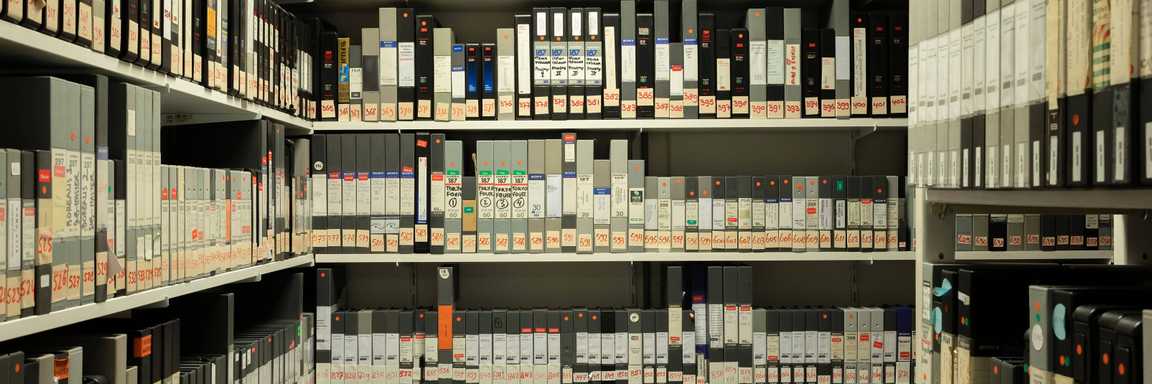
Storage
Storing Digital and Analogue Art Safely
LI-MA maintains half a century’s worth of media art through the management of our collection and those of the museums, artists, institutions, corporate- and private collectors whose works we take care of. We securely store variable media artworks using an active strategy wherein we continuously monitor them while transferring them to new carriers and formats as needed. The works are kept under state of the art conditions, provided with documentation and remain available for exhibition and research.
Storage at LI-MA
Storage of tapes, files, hardware, software and equipment is crucial in our rapidly evolving technological landscape due to the constant threat of obsolescence. Digital file formats, hardware, and software will at a certain point become outdated, rendering files inaccessible and potentially lost forever. As technology progresses, older formats may become incompatible with modern systems, making it imperative to store digital files in a manner that ensures their long-term accessibility. Without the employment of active storage strategies, media may be at risk of being lost to the sands of time.
LI-MA’s Digital Repository
To address this challenge, LI-MA has implemented a repository for media art used by over 50 collections, employing a robust digital storage strategy in line with the OAIS reference standard. LI-MA utilizes LTO (Linear Tape-Open) data tapes, known for their durability, long-term data retention capabilities as well as their guaranteed back and forward compatibility. These data tapes are stored in two separate locations, minimizing the risk of data loss due to unforeseen events such as natural disasters or hardware failures. Besides LTO tapes, a third copy of the masters is made in a different format for archival storage. Additionally, LI-MA checks twice a year all stored files to detect and rectify any corrupted data, ensuring the integrity of the digital assets they safeguard.
The Vault
In addition to digital storage, LI-MA offers a comprehensive solution for your physical storage needs. LI-MA maintains a climatized vault set to a precise temperature of 18 degrees Celsius and a humidity level of 45%. This environment has no direct sunlight, electrical, electronic or magnetic interference and is dust free. This controlled environment is ideal for preserving physical carriers such video tapes, harddisks and other media art carriers, safeguarding them against degradation and damage. LI-MA's commitment to both digital and physical storage solutions showcases their dedication to preserving our valuable heritage and its media assets for the long-term.
Monitoring is key
Digital files need to be routinely checked, due to their inherent susceptibility to various risks and challenges associated with digital data preservation.
Routine checks
Digital files, like physical objects, are vulnerable to degradation and corruption over time. Yet unlike physical objects or analog recordings, which can remain relatively stable if stored in suitable conditions, digital files are stored as bits and bytes on electronic storage media. These bits can deteriorate due to factors such as magnetic decay, electrical issues, or even software errors. Routine checks involve verifying the integrity of these files, ensuring that they remain intact and accessible. This proactive approach helps identify and address issues before they become irreversible, mitigating the risk of data loss. Routine checks involve not only verifying data integrity but also ensuring robust cybersecurity measures are in place to protect against potential threats.
Digital Obsolescence
Digital file formats and storage technologies are rapidly evolving. What may be a standard file format or storage medium today could quickly become obsolete in the future. To combat this obsolescence, LI-MA periodically migrates digital files to newer formats and storage solutions. The LTO tapes that LI-MA uses are backwards compatible for up to 3 generations. Every 3 generations of LTO tapes LI-MA migrates to the newest versions to stay up to date with new developments. Routine checks provide opportunities to assess the current state of each digital file, identify those that need migration, and plan for updates to ensure long-term accessibility.
ArtHost
How do you archive artworks that are supposed to be online and continuously accessible? This was one of the questions that led LI-MA into creating our service ArtHost.
What is ArtHost
ArtHost is a preservation service offered by LI-MA and developed in cooperation with DullTech, which is available to anyone looking to save complex digital and online artworks. By sending your documentation, source code, files and domain registrations you can rest assured that we will undertake the important job of sustainably preserving your artwork.
What does ArtHost offer?
ArtHost offers server- and browser hosting solutions to provide artists, producers and collections with sustainable ways to give access to their online artworks. This includes uploading, ingesting, checking files, documentation and maintenance.
ArtHost Workflow
When an online digital artwork is brought to li-ma for sustainable preservation first an inventorisation of its key characteristics is conducted. Does the website still work? What are its dependencies? Does the website require restoration? When these questions have been answered the domain hosting of the URL is transferred to li-ma, along with the original source code and documentation which are stored on LTO tape. LI-MA stores every website on its own virtual server setup for specific needs of that artwork.
More about ArtHost
Are you interested in the research that preceded ArtHost? Do you want to know why we made the choices we did? Please read the reports on the ArtHost Project Page.
If you are interested in storing your collection or if you would like to know more about li-ma’s options please contact us using the form below.






